Glue-on Tabs Wolf Busch "powered by Duplo"
go to the online shopA Glue-on Horseshoe You Can Rely on
Wolf Busch® glue-on tabs have already earned their place in our company history. We assume that - no matter what may come - they are and will remain the most successful product of our Innovations range ever.
Together with the former developer team RB-Carbon, consisting of Wolfgang Busch and Christian Roncassaglia, we have launched the glue-on tabs in 2019 as part of our Innovations range as the first product "powered by Duplo". Due to the dissolution of the development team, we were forced to rename the product "Wolf Busch® glue-on tabs".
Simple assembly and long durability - these were the requirements that the two developers set themselves as their goal. Both goals were met.
Among our customers, these glue-on tabs, which just like our horseshoes are a composite of two materials, have triggered a real gluing boom! At first glance, the amateur thinks: "Anyone can glue". In practice, however, a reliable glue-on horseshoe depends on many factors. On the one hand, of course, on the product used. But when it comes to gluing in particular, there are many other aspects that determine success or failure.
Our goal is to provide you with high-quality products for your glued hoof protection and to support you with a general insight into the topic of "reliable glue-on horseshoes" - because every product can only be as good as its user.
If you would like to contribute something at this point, we would be happy if you leave us your tips and tricks in the form of an item review. Of course, we are also available for a personal conversation.
Durability of the Glue-on Tabs
In the case of a plastic horseshoe, it has long been understood that the duration of the storage of the finished product has an effect on the abrasion behavior. However, what is advantageous for the horseshoe can be a disadvantage for a glue-on tab - not in terms of tear resistance, but with regard to its flexibility and pliability.
It has once again been shown how advantageous it is that we ourselves have active farriers in the company. This closeness to practice is invaluable when it comes to providing feedback and making conclusions for further product development and optimization.

The success of Wolf Busch® glue-on tabs has encouraged us to add other colors to our range in addition to the regular and the soft version. In view of the decreasing flexibility of the glue-on tabs with time, we have decided to stock less of our popular special colors. That way, we can always supply you with "fresh" gluing tabs. We thank you for your understanding if a color should be out of stock from time to time. This is only to ensure the quality of the glue-on tabs and is therefore in everyone's interest.
At the same time, we would like to ask you to apply these findings to your own storage.
Please use Wolf Busch® glue-on tabs as soon as possible on a "first in first out" basis and observe the shortened return period of one month on our glue-on tabs. We recommend to store the glue-on tabs for no more than 5 months before applying them.
Wolf Busch® Regular vs. Soft
Everyone already knows it from our horseshoes: There is the Standard and the Extra Shoe. Different plastic or different degrees of hardness have different properties depending on temperature and ground conditions.
The same applies to Wolf Busch® glue-on tabs, except that the focus in this case does not lie on abrasion but on tear resistance and flexibility in terms of the application to the hoof.
Especially in the case of irregular hoof walls, it has been experienced that the regular glue-on tabs are more difficult to handle. That is why, in cooperation with Wolfgang Busch, we have developed the soft version.
At lower temperatures, it is possible that you will have difficulties with the regular gluing tabs. In winter, the tabs are often less pliable and do not adhere as well to the hoof. Here, too, the soft version scores with more flexibility compared to the regular version.
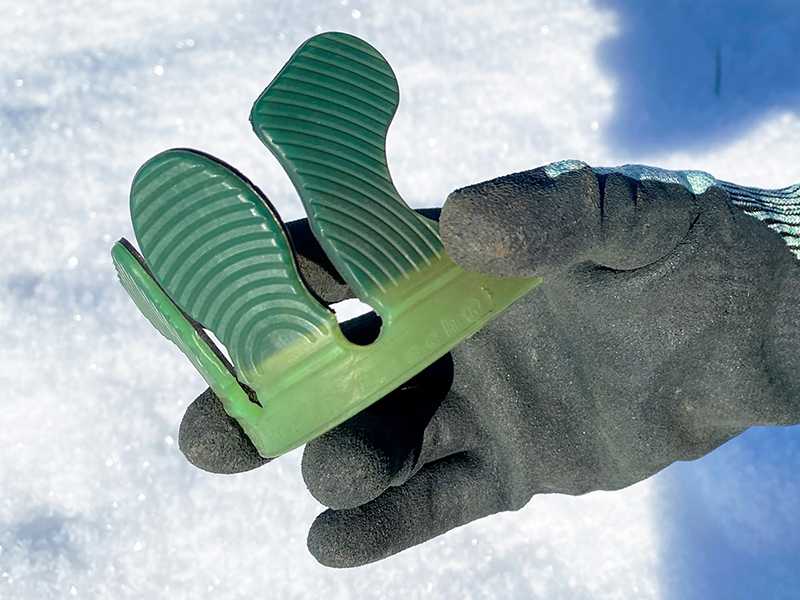
Thus, due to the slightly softer and therefore more flexible material, the soft gluing tabs are especially suitable for irregular hoof walls and lower temperatures.
Of course, irregular hoof walls do not only exist in winter - if you want to glue a horse with an irregular hoof wall outside the winter months, you can of course use the Wolf Busch® soft gluing tabs.
However, in midsummer, when temperatures can be extreme, we do not recommend using the soft version.
And irrespectively of the temperature, we recommend not using the soft version for hooves that land in a very rotary or shuffling way because of the more flexible basic material. Neither do we recommend them for sports which put a high and/or shearing strain on the fixation of the horseshoes (e.g. show jumping).
Wolf Busch® Gluing Tabs – Photos
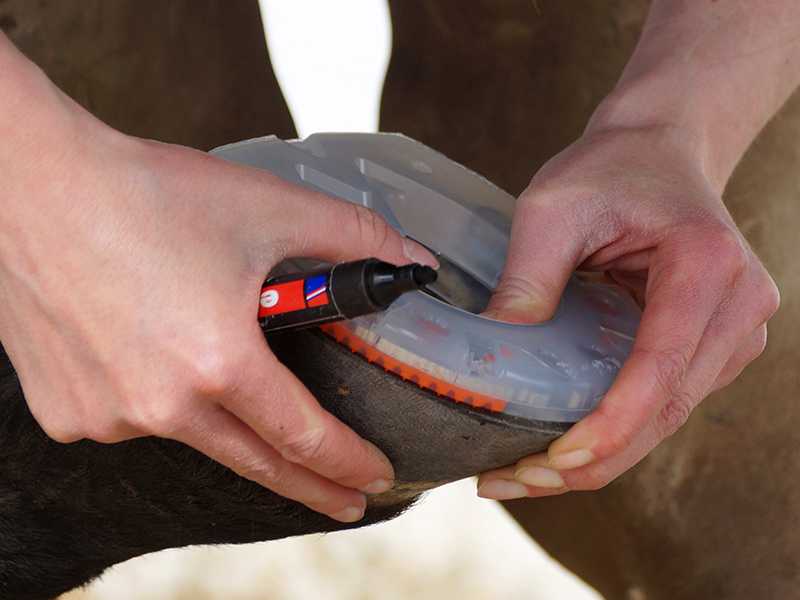
Adjust the shoe to the shape of the hoof. Allow it to extend approx. 1mm over the hoof in the area of the gluing tabs.
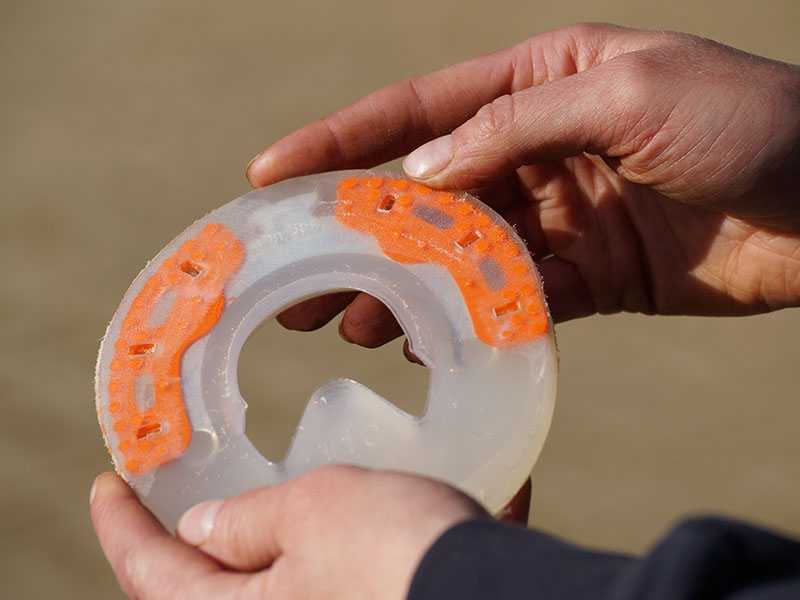
If you are using a model with knob arrays, grind them off before plastic-welding.

Our tip: regular and stable welding seams can be achieved with the help of our plastic welding device.
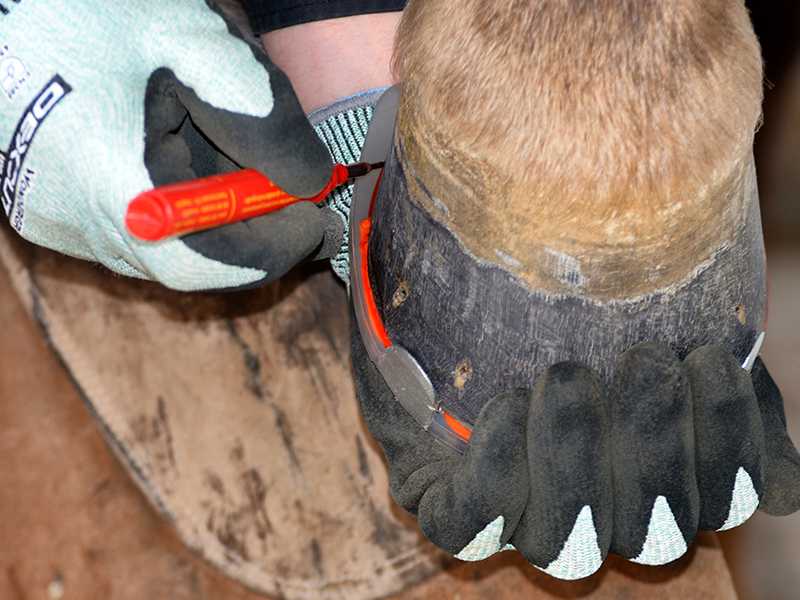
The clips provide additional protection against twisting on the hoof during the regular shoeing period.

In order to use the glue tabs in combination with a clipped composite horse shoe, divide it after the largest tab.

Place the two largest tabs before the clips. If you have only little space, exchange the right tab with the left tab.
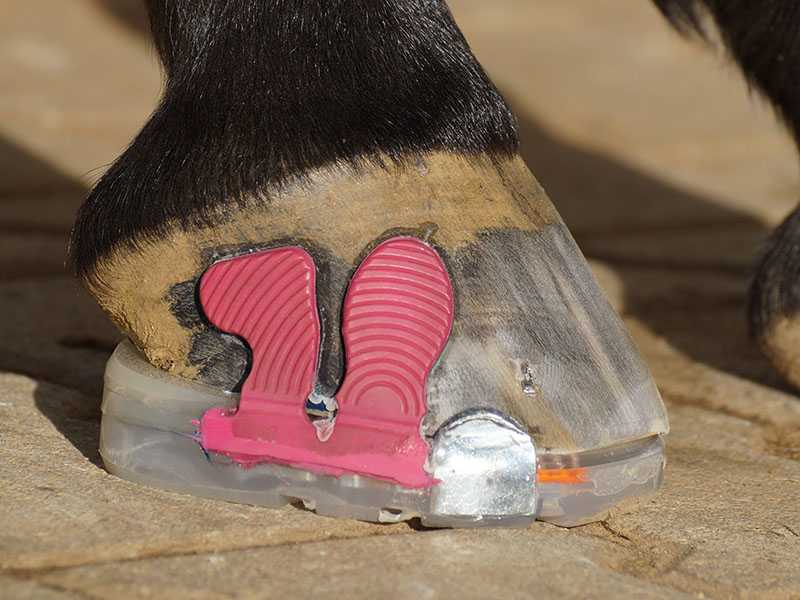
You can adjust the shoe to the individual requirements of the horse. It is also possible to combine a glued and nailed application. The photo shows a clipped horseshoe, which has been half-glued and half-nailed to the hoof, with a wedge.
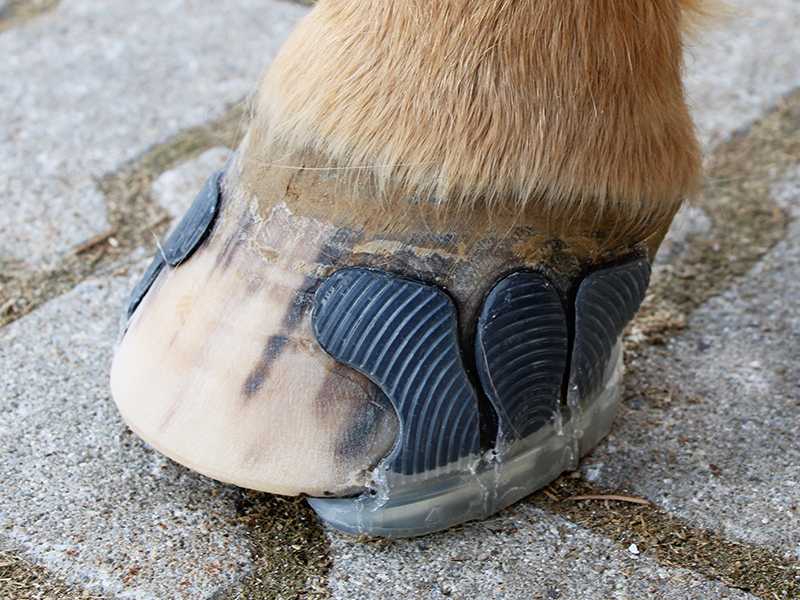
The Wolf Busch® glue tabs are also ideal for use in combination with our open toe shoes. Many of our customers use this special shoe, e.g. in case of laminitis.

Donkey hooves also sometimes need a shock-absorbing glued shoe. In this case, we have found a good solution: A glued hoof protection made of two glue-on tabs and an un-clipped horse shoe.
Application and Safety Information – Reliable Glued Horseshoes – VIDEO
Whether it is a nailed or, as in this case, glued horseshoe: There are certain safety instructions that you must take into account for the application and use of our products. Please read and follow our safety advice in order to avoid injuries to humans and horses.
Gluing Horseshoes - Step by Step
The factors that determine the success or failure of a glued horseshoe are many and multifaceted. You experience it again and again at home: Depending on the material, a different type of glue is required. If the surface is not even or clean enough, the glued connection will not hold reliably, even with the correct superglue.
In the field of glued horseshoes, other factors come into play in addition to the right superglue. These are, among other things, the correct barefoot treatment, the ideal customization of the shoe to the horse's hoof, a stable plastic welding seam, and the climatic conditions.
But don't worry: With the right equipment, a proper working method, and a bit of manual skill, a reliable end product can be created despite these many factors. In our video, Shelly Frank (certified and state-approved farrier) explains the correct application of the Wolf Busch® glue-on tabs.
If you prefer written gluing instructions, you can find them in our FAQ section → Instructions.
The Appropriate Glue-on Tabs for your Composite Horseshoe
For a reliable glued horse shoe, first select the appropriate composite horse shoe based on the shape and size of the hoof. In order to achieve the best possible ratio of glued area to hoof size, the size of the glue-on tabs depends on the size of the composite or plastic horse shoe.
- size 1 glue-on tabs for horseshoes from approx. 50mm to 70mm (3D Printing)
- size 2 glue-on tabs for horseshoes from approx. 70mm to 90mm (3D Printing)
- size 3 glue-on tabs for horseshoes from approx. 90mm to 114mm
- size 4 glue-on tabs for horseshoes from approx. 114mm to 134mm
- size 5 glue-on tabs for horseshoes from approx. 134mm to 162mm
- size 6 glue-on tabs for horseshoes from approx. 162mm to 198mm

Removing a Glued Horseshoe
With successful glued shoeing, you will ultimately face the challenge of removing the glue-on tabs from the hoof without damaging the hoof wall.
Of course, as always, different working methods lead to the intended goal.
One option is to use pliers to remove the glued horse shoe. Grasp the glued tab at the uppermost point and carefully pull the tab off the hoof. Many people like to use this method because it is simple and fast. The big disadvantage of this method is, however, that it can happen that you damage the hoof wall.
A more gentle method for the hoof wall would be to use the hoof knife to carefully separate the black connecting layer between the tab and the hoof from the top to the bottom. The remains of the inner layer of the glue tabs can then simply be rasped away during the usual treatment of the bare hoof.
Reusability of the Glue-on Tabs and/or the Glue-on Horseshoe
With our horse shoes, it is already quite normal for many customers to have the ability to use a nailed shoe multiple times. Of course, this statement cannot be generalized as the abrasion behavior and thus also the reusability depends on many aspects.
We recommend against reusing a composite horse shoe if the metal core is no longer completely covered by the plastic sheath. The final decision whether a shoe can be used again is always the responsibility of the farrier on site.
If you decide to reuse a horseshoe, it is important to straighten it before re-shoeing. This way, you will avoid tension and pressure on the hoof during the next shoeing period.
For the reusability of a glued composite horse shoe, the following requirements must be met:
- The composite horse shoe or the plastic horse shoe is reusable.
- The welding seam between the glue-on tabs and the horse shoe is completely stable and can withstand a new tear test.
- The glue-on tabs do not have any cracks.
- The inside of the Wolf Busch® gluing tabs is still completely covered with the black inner layer.

If these requirements are met, you still need to remove the remains of the superglue from the gluing tabs. The residues of the old glue would have a negative effect on the new glued connection.
If you grind off the remnants of the superglue, be aware that the grinding dust of the glue bears health risks.
For your own safety, we therefore advise you to wear protective eyewear in combination with a FFP3 mask. You can also buy this safety equipment from us.
Of course, it is also possible that you can reuse the shoe but the glue-on tabs are not suitable for another shoeing cycle. This is the case as soon as the black inner layer of the gluing tabs is no longer completely visible, or if the tabs have cracks. In this case, we recommend that you grind the remainders of the old glue-on tabs off the horseshoe before plastic-welding it with new glue-on tabs. As always, please make sure not to inhale any grinding dust.

At this point, we would like to briefly refer to our Nailless model, where the chance of re-using the composite horse shoe is higher.
From the point of view of abrasion, many customers could reuse their glued horse shoes, but have problems with small cracks in the plastic in the area of the knob arrays.
This is a phenomenon that can occur especially with a glued horse shoe. Due to the hoof growth, tractive forces are exerted on the shoe. These forces have a different effect on a glued shoe than on a nailed shoe. For this reason, the Nailless is being produced without knob arrays.
Possible Causes for Lost Glued Horseshoes
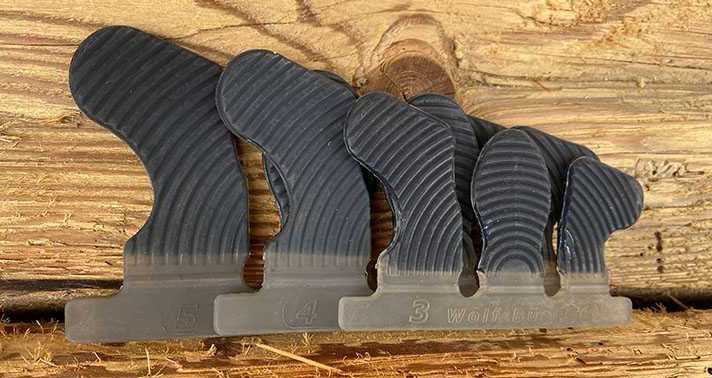
With a glued horseshoe, it is important that the glued connection is stable so that the shoe will not be lost. However, the connection should still give way in case of emergency so that the horse's tendons and ligaments are not damaged. To ensure this and at the same time achieve the best possible ratio of glued area to hoof size, Wolf Busch® gluing tabs have been designed in different sizes.
A lost glued horseshoe is often the result of an accident. What seems negative at first glance, however, is actually a good result: If the glued tabs had not given way in the emergency, you might have to call the vet instead of the farrier.
If losing a horseshoe is a more frequent scenario, it makes sense to take an examining look at the various aspects of the glued horseshoe.
Possible Causes of a Lost Glued Horseshoe with the Welding Seam being Intact:
- Is the glue tab the right size? Or does it possibly make sense to order a larger or smaller size?
- Are the shoes the right shape and size? Have they been properly customized to the hoof?
- If your horse makes large steps with its hind legs and is (despite all adjustments) prone to forging, you can add an additional protection against forging on the bottom side of the horseshoe.
Of course, it is also possible that the glued connection between the hoof and the glue tab is not strong enough. If the complete glued horseshoe is intact, but the glued connection between the tab and hoof has given way, this may have various reasons.
Possible Causes of an Insecure Glued Connection between the Hoof and the Glue-on Tab:
- The hoof was not sufficiently roughened and cleaned with sandpaper or a sanding block.
- Hoof and/or glue shoe were not degreased properly, or an unsuitable cleaning material was used (e.g. brake cleaner).
- The towel left some lint on the hoof and/or glue shoe.
- Lack of humidity: Especially in summer, the hoof or also the air may be too dry. The super glue needs a certain amount of humidity to activate. So if it is too dry overall in the summer, the superglue on the glue-on tab may harden faster than the superglue on the hoof. In addition, if the super glue lacks the humidity necessary for activation, it will take longer to harden. How a glue reacts to conditions that are too dry varies depending on the glue used.
- When it comes to gluing, the rule is: less is more. If the gluing tabs are drowned in glue, this does not necessarily lead to a better connection of the gluing tabs to the hoof.
- The superglue is suitable for the application, but was first opened a long time ago and has meanwhile absorbed humidity from the air.
- The horse was subjected to too much strain before the final hardening of the glue (often around 24 hours).
- If the gluing tabs are placed not only on the horn but also on the coronet band, the glued connection becomes unstable. This can happen either because the tabs are too big or if they are placed at the wrong place on the hoof. Should the tabs in the back of the hoof be too large, you can easily solve the problem: simply cut off a small piece at the top of the tab, so that the coronet band remains free.
Possible Causes for an Insecure Plastic Welding Seam:
Another aspect is, of course, the welding seam. If the undamaged gluing tabs stick to the horse's hoof, but the horseshoe itself has been lost, it is usually due to the plastic welding seam.
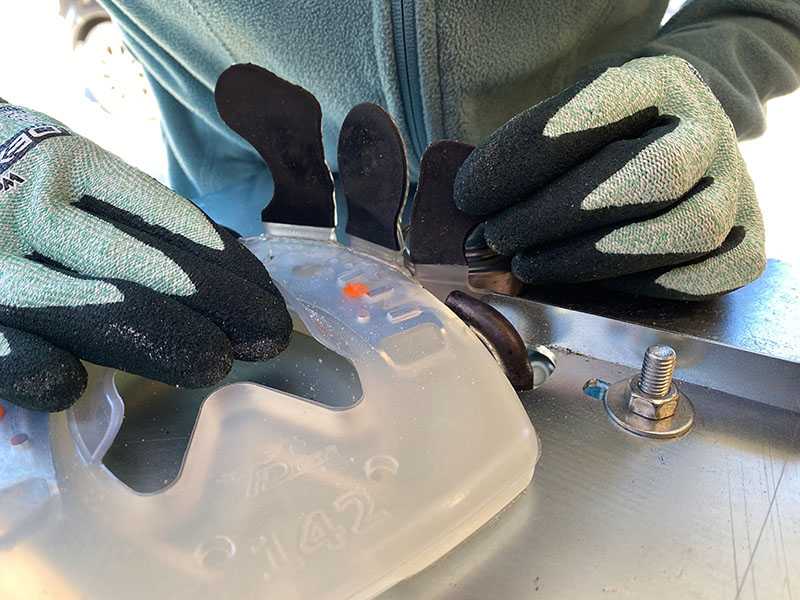
The most important criterion for the welding seam is a glassy bulge which should be visible along the entire plastic welding seam.
During the plastic welding process, the most important thing is to apply the correct uniform pressure and the appropriate rolling speed.
The Wolf Busch® gluing tabs can be combined with almost all horseshoes from our product range. However, the synthetic material of the different glue tabs has slightly different melting points. Depending on the glue-on tab used, you will therefore have to adjust the speed, apply a little more or less pressure when plastic-welding, and sometimes adjust the temperature of the hot-air gun.
For uniform and thus stable welding seams, you can buy a special plastic welding device from us. We recommend that you always check the tear resistance of the cooled welding seam before gluing the horseshoe to the hoof.
Don't worry - you can't pull too hard when doing the tear test, because the forces acting on the horse's hoof will always be many times stronger.
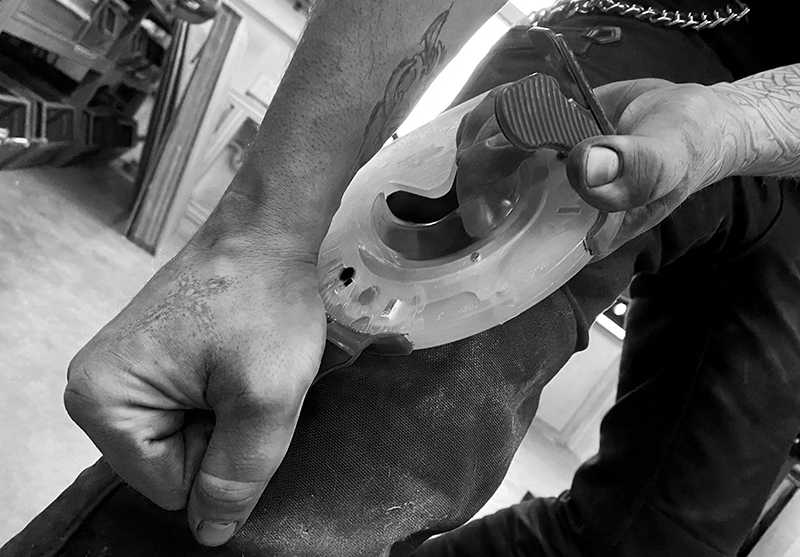
Product Features
| Model | Wolf Busch® Glue-On Tabs |
|---|---|
| Brand | Wolf Busch® |
| Versions | regular without added color; regular in hoof colors (light and dark); regular in special colors (blue, green, pink) soft in light green |
| Function | alternative hoof protection, glue shoe, glue-on horseshoe, glued hoof protection, gluing tabs |
| Riding Styles and Disciplines | among others: leisure riding and orienteering, tail riding, endurance, western riding, dressage, gaited horse riding, baroque riding, ground work, cross-country riding, working equitation |
| Admission for Tournaments | Our composite horseshoes are approved for various tournaments; for more information please
contact the respective association (e.g. AQHA, DWA, FEIF, FISE, FN, IPZV, OEPS, SVPS). |
| Therapy Shoe | In combination with a composite horseshoe, the glue-on tabs are also suitable for supportive use in orthopedic and therapeutic applications. We expressly point out that our products do not diagnose or cure any diseases and advise for any use with a therapeutic or orthopedic background to work closely with the hoof specialist or veterinarian on site. |
| Horse Breeds | a.o. Warmblood, Thoroughbred, Quarter Horse, Paint Horse, Haflinger, Icelandic, Arabian, Friesian, Andalusian, Hanoverian |
| Gluing Instruction | can be found unter FAQ → Instructions |
| Security Advice | can be found under FAQ → Safety Information. Also observe the safety instructions for the glue used. |
| Made in | Germany |
| Available Sizes | 1 (3D Printing), 2 (3D Printing), 3, 4, 5, 6 |
| Sizing | The appropriate size is based on the horseshoe used. |
| Accessories | super glue, hoof cleaner (e.g. Megafoam), abrasive block , welding device, hot-air gun and reduction nozzle |
| Packaging Unit | The glue tabs are sold in pairs. For one hoof, you usually need a pair of glue tabs. |
| Shipment | within Canada — for worldwide shipments please contact the Duplo Team in Germany |
Tips and Tricks
At this point we would like to give you some more information that we find helpful in everyday life.

Gluing in Case of a Clipped Hoof Protection
If you want to combine the Wolf Busch® glue-on tabs with a clipped horseshoe, cut the gluing tabs between the largest and the second-largest tab. Place the largest tab in front of the clip and the other two tabs behind it.
If you run out of space in the toe area, it may happen that the two largest tabs overlap. For more space in the toe area, you can exchange the two largest tabs, as shown on the photo.
Please note that this procedure also applies if you have removed the clips from a clipped composite horseshoe. It is not possible to create a welding seam in the area where the clips have been ground off.
A Good Choice in Combination with Straight Toe or Open-Toed Horseshoes
The advantage of Wolf Busch® gluing tabs is that they are not a continuous collar, but consist of a right and a left tab.
This makes Wolf Busch® gluing tabs more suitable than our Pro and Easy gluing collars for the application in combination with a specially shaped toe area (straight toe or open toe).
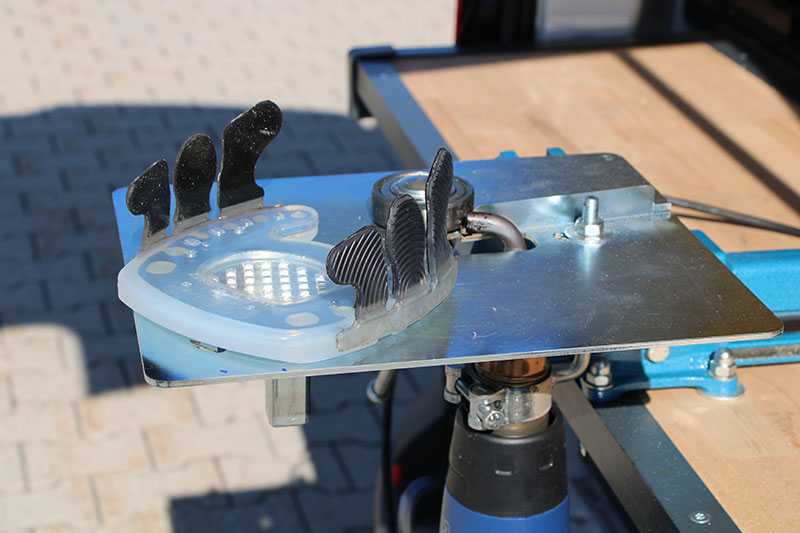
Gluing in Winter
As mentioned above, Wolf Busch® soft gluing tabs were developed for the use during the winter and for irregular hoof walls. However, we know that many of our customers also use the regular glue-on tabs for their glue-on shoe at lower temperatures. Of course, there is nothing wrong with this.
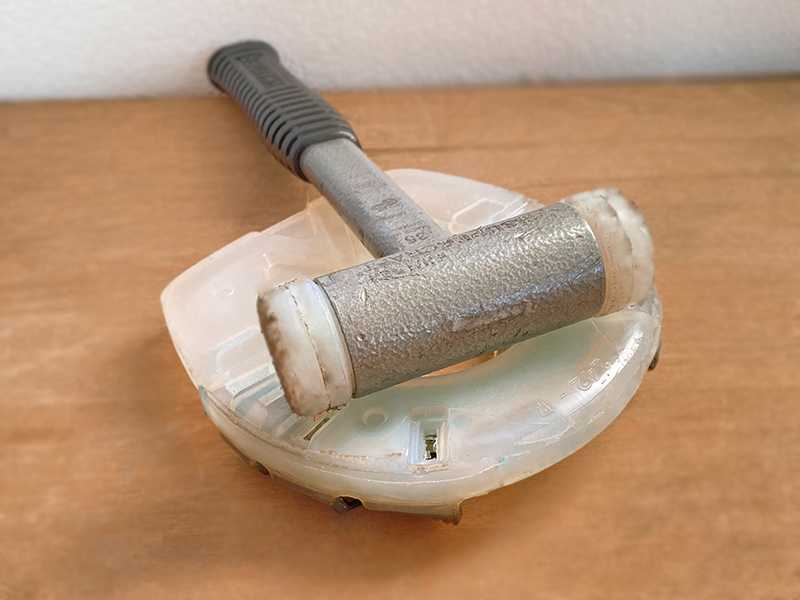
In general, the regular glue-on tabs are ready for use throughout the year. However, it can be more difficult to glue the individual glue tabs correctly to the hoof due to the lower temperatures.
We have experienced that in difficult cases, the following trick can be helpful to glue the tabs to the hoof wall: Slightly warm up the tabs of the ready-made glue shoe. Place the glue horseshoe on the tabs and use your hammer, for example, to slightly press them down from above. Thanks to this little trick, the tabs have a certain curve after they have cooled down, which makes it easier to glue them to the hoof.
Like the flexibility of the synthetic material, the viscosity of the super glue also changes depending on the temperature. In winter, we usually recommend the winter glue or the medium glue.
If you have problems gluing due to the flexibility of the gluing tab or the shape of the hoof wall, the MD-Blitzschnell can provide a helping hand. Because this glue hardens very quickly regardless of temperature, you do not have to press the glue-on tabs against the hoof wall for such a long time.
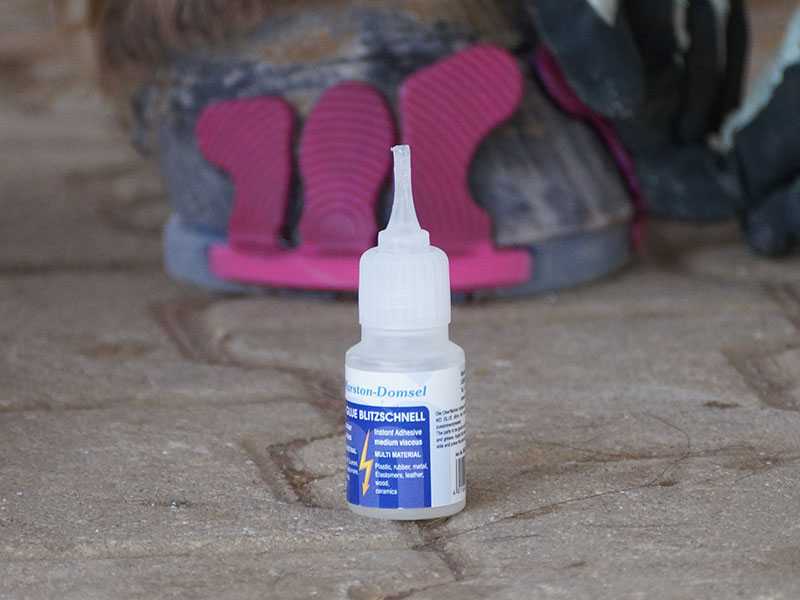

Do not use Brake Cleaner Fluid for Degreasing the Hooves and the Glue-on Tabs
Both break cleaner fluids with and without acetone reduce the tear strength of the colored elastomer on the glue-on tabs.
Depending on the intensity and duration of the application, the effect varies between "hardly noticeable" and "extremely damaging". Since we cannot make sure that the fluids are applied shortly and gently enough, we generally do not recommend using them for glue-on horseshoes.
Necessity is the Mother of Invention - Glued Hoof Protection for Donkeys
What applies to our horseshoes, of course, also applies to the gluing tabs: Sometimes there are challenges in the everyday life of a farrier to which he has to react in a flexible way.
That's what happened to Shelly and Sandy Frank when they had to apply a glued hoof protection to a donkey. In this case, they not only modified the horseshoe, but also used an additional glue-on tab.

This shows once again that all general information we give to you can only ever apply to the ideal case. Exceptions, as always, confirm the rule and therefore always require the expertise and skill of the farrier on site.

